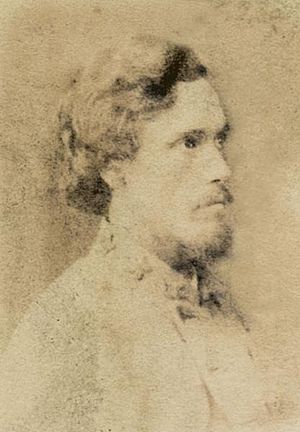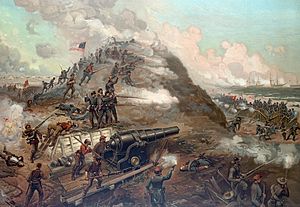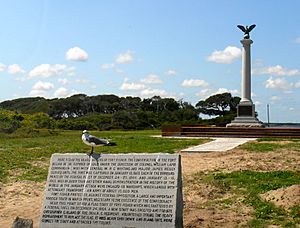William Lamb (Confederate States Army officer) facts for kids
William Lamb (born September 7, 1835 – died March 23, 1909) was an important American newspaper editor, politician, businessman, and soldier. He is best known for being a Confederate Army officer who commanded the soldiers protecting Fort Fisher during the American Civil War. This fort was very important because it guarded the mouth of the Cape Fear River.
Contents
William Lamb's Early Life
William Lamb was born in Norfolk, Virginia. His parents were William Wilson and Margaret Kerr Lamb. He went to the Rappahannock Military Academy and then studied law at The College of William & Mary in Williamsburg, Virginia.
After finishing college in 1855, Lamb returned to his family home, Kenmure, in Norfolk. He became a co-owner and editor of a local newspaper called the Southern Argus. He also got involved in local politics. He was chosen as a delegate for the Democratic National Convention and supported certain politicians for president in 1860.
Lamb's Role in the Civil War
Before the Civil War, William Lamb was active in the state militia. He led a group called the Woodis Rifles, which was formed in Norfolk in 1858. This group was sent to Harpers Ferry, West Virginia in 1859 during an event known as John Brown's raid on Harpers Ferry.
When the Civil War began, Lamb became a major in the Confederate Army in September 1861. He worked as a quartermaster, which meant he was in charge of supplies. He first oversaw Fort St. Philip, which was later renamed Fort Anderson. In 1862, Lamb was chosen to be the colonel of the 36th North Carolina Regiment.
Building Fort Fisher
On July 4, 1862, Colonel Lamb took command of Fort Fisher. This fort was located on a narrow piece of land called the Federal Point peninsula. It protected the New Inlet, which was a waterway leading into the Cape Fear River. This made Fort Fisher extremely important for the city of Wilmington, North Carolina, allowing ships to bring supplies to the Confederacy.
When Lamb first arrived, he saw that the fort was small and not very strong. He said it was "a small work, part of it constructed of perishable sand bags." It only had a few large guns that were good for defending against ships.
Even though he wasn't trained as an engineer, Lamb was very interested in military forts. He studied how forts were built and defended, especially learning from the Russian fortress of Malakoff during the Crimean War. For two and a half years, Lamb worked tirelessly to make Fort Fisher much stronger. He built it into the Confederacy's largest fort, stretching over seven hundred yards. It became known as the South’s Gibraltar because it was so strong.
Defending Fort Fisher
Fort Fisher was very important to the Confederacy because it was one of the last open ports for supplies. Colonel Lamb successfully defended the fort against a Union attack led by Benjamin Butler and David Dixon Porter in December 1864.
However, two weeks later, in January 1865, the Union Army launched another attack. This time, Alfred Terry replaced Butler, and Admiral Porter led the naval forces. They brought a very large force of 8,000 soldiers and over 600 ship guns against fewer than 2,000 Confederate defenders.
Despite fierce fighting by Lamb and his soldiers for two days, Fort Fisher was captured. About 500 Confederate soldiers were lost, while the Union had nearly three times more casualties. Lamb was seriously wounded during the battle and was taken prisoner.
He was sent to a U.S. Army hospital where he met Union Colonel Newton Martin Curtis. Colonel Curtis had also been badly wounded during the Second Battle of Fort Fisher and had lost an eye. Despite being on opposite sides, they became friends. Later, they worked together to help calm tensions between the North and South after the war.
Later Life and Legacy
William Lamb eventually recovered from his wounds. From 1880 to 1886, he served as the mayor of Norfolk, Virginia, just like his father and grandfather had before him. He was first a member of the Democratic Party but later joined the Republican Party in 1882.
In 1900, he was honored as a Knight of the Order of Vasa for his work as a consul for Sweden and Norway. William Lamb passed away in Norfolk on March 23, 1909, and is buried there in Elmwood Cemetery. His personal papers are kept at the Special Collections Research Center at The College of William & Mary.
His family home in Norfolk, Kenmure, was recognized as a historic place in 1988.
Images for kids





